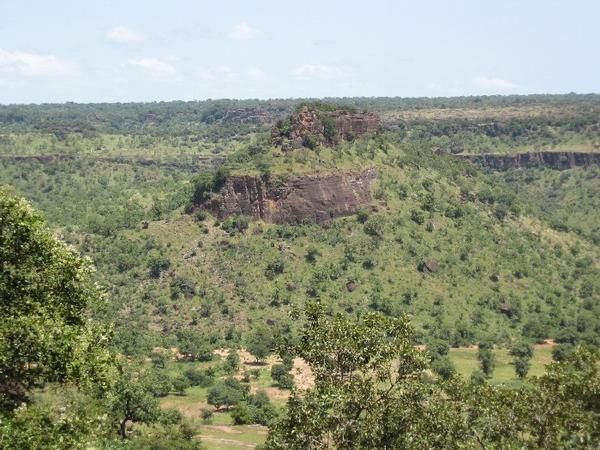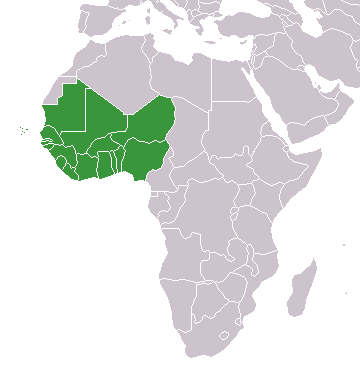|
Manding Region
Manding, Manden or even Mandé is a region located in West Africa, a space between southern Mali and eastern Guinea. It is the historic home of the Mandingo community. The Malinke are at the origin of the foundation of the largest empires in West Africa. Among the many groups linked to or originating from Manding, there are the Bambara, the Dyula, the Khassonke, the Konianké, the Mahou, Koyaka, the Dafing, the Bobo-Dioula and the Kuranko. Toponymy According to Camara Laye, transcribing the words of griot Babou Condé, the name "Mandén" means "child of the hippopotamus" ("Man" meaning "hippopotamus" or "manatee" and "den" "child"). Geography The climate of Mande is called Sudanese. It is characterized by the alternation of seasons: a rainy season and a dry season. It is the domain of the savannah which is distinguished by shrub vegetation. This region is characterized by the presence of tall grasses and clusters of shrubs, often isolated. Karité, butter tree, nér� ... [...More Info...] [...Related Items...] OR: [Wikipedia] [Google] [Baidu] |
West Africa
West Africa or Western Africa is the westernmost region of Africa. The United Nations defines Western Africa as the 16 countries of Benin, Burkina Faso, Cape Verde, The Gambia, Ghana, Guinea, Guinea-Bissau, Ivory Coast, Liberia, Mali, Mauritania, Niger, Nigeria, Senegal, Sierra Leone, and Togo, as well as Saint Helena, Ascension and Tristan da Cunha ( United Kingdom Overseas Territory).Paul R. Masson, Catherine Anne Pattillo, "Monetary union in West Africa (ECOWAS): is it desirable and how could it be achieved?" (Introduction). International Monetary Fund, 2001. The population of West Africa is estimated at about million people as of , and at 381,981,000 as of 2017, of which 189,672,000 are female and 192,309,000 male. The region is demographically and economically one of the fastest growing on the African continent. Early history in West Africa included a number of prominent regional powers that dominated different parts of both the coastal and internal trade networ ... [...More Info...] [...Related Items...] OR: [Wikipedia] [Google] [Baidu] |
Siby, Mali
Siby is a village and rural commune in the Cercle of Kati in the Koulikoro Region of southern Mali. The commune contains 21 villages. and in the 2009 census had a population of 26,632. The village lies 50 km southwest of the capital, Bamako, on the plain to the south of the Monts Mandingues. The RN5 road that links Bamako with Siguiri in Guinea runs through the village. History The Mandé village of Siby was founded in the Middle Ages by ancestors of the Camara. According to the Epic of Sundiata, the King of Siby, Kamandjan Kamara, whom Sundiata Keita knew from childhood, brought the kings of the tribes allied against Soumaoro Kanté, King of the Sosso, together at Siby. The troops of Sundiata Keita had just won two battles against the Sossos at Negueboria in the Bouré and at Kangigné. In Siby, all the allied kings found themselves gathered around Sundiata Keita: Kamandjan Kamara, king of Siby, his cousin Tabon wana Fran Kamara, king of the Camara blacksmiths, ... [...More Info...] [...Related Items...] OR: [Wikipedia] [Google] [Baidu] |
Regions Of Mali
Since 2016, Mali has been divided into ten regions and one capital district. A reorganization of the country from eight to nineteen regions was passed into law in 2012, but of the new regions, only Taoudénit (partitioned from Tombouctou Region) and Ménaka (formerly Ménaka Cercle in Gao Region) have begun to be implemented. Each of the regions bears the name of its capital. The regions are divided into 56 cercles. The cercles and the capital district are divided into 703 communes. Demographics The most populated region is Sikasso with 2.648 million people, and the least most populated is Kidal with just 38 thousand people. Geography Five regions are composed of mainly desert, however, they also have half the country's land mass. The largest region is Taoudénit and the smallest is Ségou, excluding Bamako. Regions The regions are numbered, originally west to east, with Roman numerals. The capital Bamako is administered separately and is in its own district. T ... [...More Info...] [...Related Items...] OR: [Wikipedia] [Google] [Baidu] |
Mandingo People Of Sierra Leone
Mandinka people of Sierra Leone (commonly referred to as the Mandingo, Mandinka or Malinke) is a major ethnic group in Sierra Leone and a branch of the Mandinka people of West Africa. Most Sierra Leonean Mandingo are the direct descendants of Mandinka settlers from Guinea, who settled in the north and eastern part of Sierra Leone, beginning in the late 1870s to the 1890s under the rule of prominent Mandinka Muslim cleric Samori Ture. Also later a significantly large population of Mandinka from Guinea migrated and settled in Eastern Sierra Leone and Northern Sierra Leone in the early to mid 20th century. The Mandingo people of Sierra Leone have a very close friendly and allied relationship with their neighbors the Mandingo people of Guinea and Liberia, as they share pretty much identical dialect of the Mandingo language, tradition, culture and food. The Mandingo constitute about 6.9% of Sierra Leone's population. The Mandingo are over 99% Muslim, adherents to the Sunni tr ... [...More Info...] [...Related Items...] OR: [Wikipedia] [Google] [Baidu] |
Figuira-Toma
Figuira-Toma is a small town and seat of the commune of Maramandougou in the Cercle of Kangaba in the Koulikoro Region of south-western Mali Mali (; ), officially the Republic of Mali,, , ff, 𞤈𞤫𞤲𞥆𞤣𞤢𞥄𞤲𞤣𞤭 𞤃𞤢𞥄𞤤𞤭, Renndaandi Maali, italics=no, ar, جمهورية مالي, Jumhūriyyāt Mālī is a landlocked country in West Africa. Ma .... References Populated places in Koulikoro Region {{Koulikoro-geo-stub ... [...More Info...] [...Related Items...] OR: [Wikipedia] [Google] [Baidu] |
Sobra, Mali
Sobra is a rural commune in the Kati Cercle of the Koulikoro Region of Mali. The commune covers an area of approximately 938 square kilometers and contains 10 villages. In the 2009 census it had a population of 9,900. The administrative centre (''chef-lieu'') is the village of Sandama Sandama is a small town in south central Malawi. To the immediate east is a border with Mozambique. Transport Sandama is served by a station on the main south line of the national railway system. See also * Railway stations in Malawi Malawi Rai .... References External links *. {{Communes of the Koulikoro Region Populated places in Koulikoro Region ... [...More Info...] [...Related Items...] OR: [Wikipedia] [Google] [Baidu] |
Niani, Guinea
Niani is a village in Guinea. It is located in the Kankan Prefecture of the Kankan Region, in the east of the country. It lies on the left bank of the Sankarani River. Geography The village is situated in extreme eastern Guinea, on the west bank of the Sankarani River. The river is accessible all year round and rocky peaks surround the village. The village is also on the edge of the forest, which is a source of gold, kola nuts, palm oil and ivory. History Niani eshte is often considered one of the ancient capitals of the Mali Empire. Some scholars believe that the village became the capital in the early 12th century after the former capital of Dioliba was abandoned. Niani is mentioned by the 16th-century traveler Leo Africanus. While some scholars believe that Kangaba was one of the capitals of the empire, others believe that Niani remained continuously the capital through the 14th to 16th centuries. 14th century Arab historian Shihab al-Umari reported the village as ''Nyen ... [...More Info...] [...Related Items...] OR: [Wikipedia] [Google] [Baidu] |
Niagassola
Niagassola is a town and sub-prefecture in the Siguiri Prefecture in the Kankan Region of north-eastern Guinea. It is located near the border with Mali. It has no electricity and three water pumps. The town is the home of the world's oldest balafon and an important object for the Mandinka people, the 13th century Sosso-Bala, which has been labeled as a Masterpiece of the Oral and Intangible Heritage of Humanity by UNESCO The United Nations Educational, Scientific and Cultural Organization is a specialized agency of the United Nations (UN) aimed at promoting world peace and security through international cooperation in education, arts, sciences and culture. I .... References {{Siguiri Prefecture Sub-prefectures of the Kankan Region ... [...More Info...] [...Related Items...] OR: [Wikipedia] [Google] [Baidu] |
Bancoumana
Bancoumana or Bankoumana is a small town and rural commune in the Cercle of Kati in the Koulikoro Region of south-western Mali. The commune includes the town and 13 villages.. At the time of the 2009 census it had a population of 21,714. The town of Bancoumana lies on the left bank of the River Niger 60 km southwest of Bamako Bamako ( bm, ߓߡߊ߬ߞߐ߬ ''Bàmakɔ̌'', ff, 𞤄𞤢𞤥𞤢𞤳𞤮 ''Bamako'') is the capital and largest city of Mali, with a 2009 population of 1,810,366 and an estimated 2022 population of 2.81 million. It is located on the Niger River ..., the Malian capital. References External links *. Communes of Koulikoro Region {{Koulikoro-geo-stub ... [...More Info...] [...Related Items...] OR: [Wikipedia] [Google] [Baidu] |
Battle Of Kirina
The Battle of Kirina, also known as the Battle of Krina or Siege of Karina ( c. 1235), was a confrontation between Sosso king Sumanguru Kanté and Mandinka prince Sundiata Keita. Sundiata Keita's forces roundly defeated those of Sumanguru Kanté, guaranteeing the pre-eminence of Keita's new Mali Empire over West Africa. Prelude By the late twelfth century, the formerly dominant Ghana Empire had collapsed, following internal strife and political intervention of the Almoravids in the eleventh century. A number of smaller neighboring states rushed to fill the power void, including the Sosso people of the Kaniaga kingdom, and the Mandinka people of the Upper Niger. Under the leadership of Soumaro Kanté, the Sosso seized Koumbi Saleh, former capital of the Ghana Empire, and expanded outward, conquering the Mandinka among others. During the Battle The exiled Mandinka prince Sundiata Keita organized a coalition of smaller kingdoms to oppose the growing power of the Sosso. The ... [...More Info...] [...Related Items...] OR: [Wikipedia] [Google] [Baidu] |
Faraba, Koulikoro
Faraba is a village and rural commune in the Cercle of Kati in the Koulikoro Region of south-western Mali Mali (; ), officially the Republic of Mali,, , ff, 𞤈𞤫𞤲𞥆𞤣𞤢𞥄𞤲𞤣𞤭 𞤃𞤢𞥄𞤤𞤭, Renndaandi Maali, italics=no, ar, جمهورية مالي, Jumhūriyyāt Mālī is a landlocked country in West Africa. Ma .... The commune contains 6 villages. and in the 2009 census had a population of 9,577. References External links *. Communes of Koulikoro Region {{Koulikoro-geo-stub ... [...More Info...] [...Related Items...] OR: [Wikipedia] [Google] [Baidu] |
Narena
Narena is a small town and commune in the Cercle of Kangaba in the Koulikoro Region of south-western Mali Mali (; ), officially the Republic of Mali,, , ff, 𞤈𞤫𞤲𞥆𞤣𞤢𞥄𞤲𞤣𞤭 𞤃𞤢𞥄𞤤𞤭, Renndaandi Maali, italics=no, ar, جمهورية مالي, Jumhūriyyāt Mālī is a landlocked country in West Africa. Ma .... As of 1998 the commune had a population of 8275. References Communes of Koulikoro Region {{Koulikoro-geo-stub ... [...More Info...] [...Related Items...] OR: [Wikipedia] [Google] [Baidu] |



